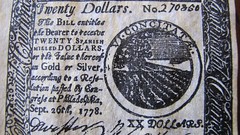
PREV ARTICLE
NEXT ARTICLE
FULL ISSUE
PREV FULL ISSUE
THE PRE-HISTORY OF THE US DOLLAR
Dick Hanscom forwarded this BBC News article about the "pre-history" of the U.S. dollar. Thanks.
-Editor
Jason Goodwin, author of Greenback: the Almighty Dollar and the Invention of America sums up the difficulty: "They simply didn't have any cash. They weren't very loaded when they came over in the first place. And it became quite awkward for the colonists to do exchanges between themselves… it was all very well to barter one thing for another, but of course quite soon you get into quite complex exchanges, and that's where money is so incredibly useful." Soon after their arrival, the settlers discovered that certain kinds of shell - known as wampum - had great symbolic significance for many native Americans and as such could be exchanged by the English colonists for the things they needed, such as food. In fact, the wampum became so important in the early days of trading in what is now the Eastern seaboard of the US that in 1637 the Massachusetts Bay Colony declared them to be legal tender. As trade among the settlers themselves became increasingly important, they started to use other goods for bartering. In the northern colonies they used corn and cod, for example, and in the more southerly colonies they also favoured tobacco. Many of these goods were declared legal tender at one time or another, although not all proved successful. Goodwin also points out that when the settlers tried using nails some were tempted to burn down wooden barns in order to extract the nails, which had a value similar to money.
To read the complete article, see:
The pre-history of the US dollar
(www.bbc.co.uk/news/magazine-25119865)
The Numismatic Bibliomania Society is a non-profit organization promoting numismatic literature. See our web site at coinbooks.org. To submit items for publication in The E-Sylum, write to the Editor at this address: whomren@gmail.com To subscribe go to: https://my.binhost.com/lists/listinfo/esylum All Rights Reserved. NBS Home Page Contact the NBS webmaster 
|
